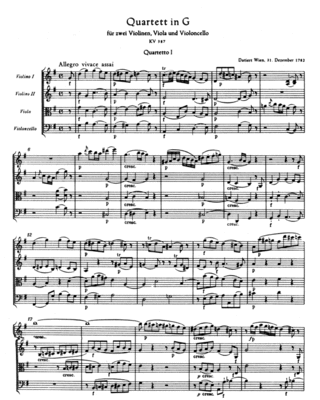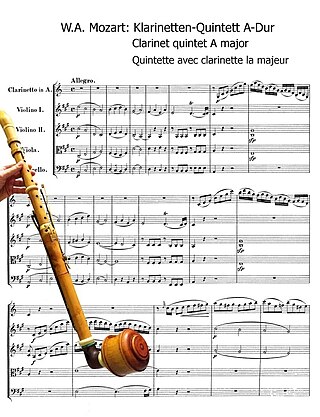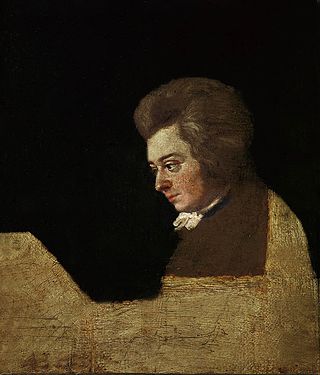Sonata form is a musical structure generally consisting of three main sections: an exposition, a development, and a recapitulation. It has been used widely since the middle of the 18th century.

Ludwig van Beethoven's String Quartet No. 11 in F minor, Op. 95, from 1810, was his last before his late string quartets. It is commonly referred to as the "Serioso," stemming from his title "Quartett[o] Serioso" at the beginning and the tempo designation for the third movement.

Ludwig van Beethoven's Symphony No. 1 in C major, Op. 21, was dedicated to Baron Gottfried van Swieten, an early patron of the composer. The piece was published in 1801 by Hoffmeister & Kühnel of Leipzig. It is not known exactly when Beethoven finished writing this work, but sketches of the finale were found to be from 1795.
A Musical Joke K. 522, is a composition by Wolfgang Amadeus Mozart; the composer entered it in his Verzeichnis aller meiner Werke on June 14, 1787. Commentators have opined that the piece's purpose is satirical – that "[its] harmonic and rhythmic gaffes serve to parody the work of incompetent composers" – though Mozart himself is not known to have revealed his actual intentions.

The Grosse Fuge, Op. 133, is a single-movement composition for string quartet by Ludwig van Beethoven. An immense double fugue, it was universally condemned by contemporary music critics. A reviewer writing for the Allgemeine musikalische Zeitung in 1826 described the fugue as "incomprehensible, like Chinese" and "a confusion of Babel". However, critical opinion of the work has risen steadily since the early 20th century and it is now considered among Beethoven's greatest achievements. Igor Stravinsky described it as "an absolutely contemporary piece of music that will be contemporary forever".

Ludwig van Beethoven's String Quartet No. 10 in E-flat major, Op. 74, was written in 1809 and is nicknamed the "Harp" quartet.

The String Quartet No. 14 in G major, K. 387, nicknamed the "Spring" quartet, was composed by Wolfgang Amadeus Mozart in 1782 while in Vienna. In the composer's inscription on the title page of the autograph score is stated: "li 31 di decembre 1782 in vienna". The work was perhaps edited in 1783. This is the first of the Haydn Quartets, a set of six string quartets he wrote during his first few years in Vienna and dedicated to Joseph Haydn.

Wolfgang Amadeus Mozart's Clarinet Quintet, K. 581, was written in 1789 for the clarinetist Anton Stadler. A clarinet quintet is a work for one clarinet and a string quartet. Although originally written for basset clarinet, in contemporary performances it usually is played on a clarinet in A. It is Mozart's only completed clarinet quintet and is one of the earliest and best-known works, written especially for the instrument. It remains to this day one of the most admired of the composer's works. Sometimes the quintet is referred to as the Stadler Quintet; Mozart so described it in a letter of April 1790. Mozart also wrote a trio for clarinet, viola, and piano for Stadler, the so-called Kegelstatt Trio, in 1786. Stadler was a friend to Mozart who was very talented in the instrument.

The Violin Concerto No. 5 in A major, K. 219, often referred to by the nickname "Turkish", was written by Wolfgang Amadeus Mozart in 1775, premiering during the Christmas season that year in Salzburg. It follows the typical fast–slow–fast musical structure.

The Kegelstatt Trio, K. 498, is a piano trio for clarinet, viola and piano in E-flat major by Wolfgang Amadeus Mozart.
The Divertimento in E♭ major, K. 563, is a string trio, written by Wolfgang Amadeus Mozart in 1788, the year in which he completed his last three symphonies and his "Coronation" Piano Concerto. It is his last divertimento and different from his other divertimenti not only in its instrumentation but also in its compositorial ambition and scope.

The "Haydn" Quartets by Wolfgang Amadeus Mozart are a set of six string quartets published in 1785 in Vienna as his Op. 10, dedicated to the composer Joseph Haydn, who is often referred to as the "father of the string quartet". Haydn had recently completed his influential Op. 33 String Quartets set in 1781, the year that Mozart arrived in Vienna. They contain some of Mozart's most memorable melodic writing and refined compositional thought.
The six String Quartets, Op. 76, by Joseph Haydn were composed in 1797 or 1798 and dedicated to the Hungarian count Joseph Georg von Erdődy (1754–1824). They form the last complete set of string quartets that Haydn composed. At the time of the commission, Haydn was employed at the court of Prince Nicolaus Esterházy II and was composing the oratorio The Creation as well as Princess Maria Hermenegild Esterházy's annual mass.
The Op. 33 String Quartets were written by Joseph Haydn in the summer and Autumn of 1781 for the Viennese publisher Artaria. This set of string quartets has several nicknames, the most common of which is the "Russian" quartets, because Haydn dedicated the quartets to the Grand Duke Paul of Russia and many of the quartets were premiered on Christmas Day, 1781, at the Viennese apartment of the Duke's wife, the Grand Duchess Maria Feodorovna. Some scholars theorize that the "Russian" quartets were the inspiration for Mozart's six string quartets dedicated to Haydn, but no direct evidence has been found.
Wolfgang Amadeus Mozart's String Quartet No. 17 in B-flat major, K. 458, nicknamed "The Hunt", is the fourth of the Quartets dedicated to Haydn. It was completed in 1784. It is in four movements:
- Allegro vivace assai
- Menuetto and Trio. Moderato
- Adagio, in E-flat major
- Allegro assai

The six string quartets Op. 20 by Joseph Haydn are among the works that earned Haydn the sobriquet "the father of the string quartet". The quartets are considered a milestone in the history of composition; in them, Haydn develops compositional techniques that were to define the medium for the next 200 years.

The String Quartets, Op. 50, were composed by Joseph Haydn in 1787. The set of six quartets was dedicated to King Frederick William II of Prussia. For this reason the set is commonly known as the Prussian Quartets. Haydn sold the set to the Viennese firm Artaria and, without Artaria's knowledge, to the English publisher William Forster. Forster published it as Haydn's Opus 44. Haydn's autograph manuscripts for Nos. 3 to 6 of the set were discovered in Melbourne, Australia, in 1982.

The Piano Quartets, WoO 36, by Ludwig van Beethoven are a set of three piano quartets, completed in 1785 when the composer was aged 14. They are scored for piano, violin, viola and cello. He composed a quartet in C major, another in E-flat major, and a third in D major. They were first published posthumously in 1828, however numbered in a different order: Piano Quartet No. 1 in E-flat major, Piano Quartet No. 2 in D major, and Piano Quartet No. 3 in C major.


















